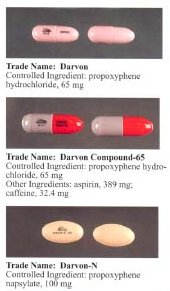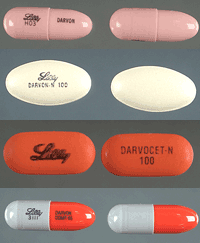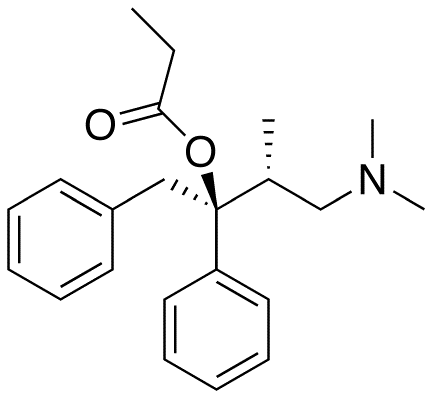

這個藥物之前就被fda密切關注過:
不如來知道一下他的結構式:

機轉:
1) Propoxyphene is a mild analgesic and has been extensively used in virtually every type of pain. Propoxyphene is available as the hydrochloride and as the napsylate salt which is more stable than the hydrochloride. Due to differences in molecular weights, doses of 100 mg napsylate is approximately equivalent to 65 mg of the hydrochloride (Anon, 1972a).
2) Propoxyphene hydrochloride and napsylate are used for mild to moderate pain including pain in cancer patients, musculoskeletal disorders, episiotomy pain, backache, arthritis, headache, and pain in orthopedic patients (Cohen et al, 1966; Nicolis et al, 1968); (Lamphier, 1969)(Gruber, 1977; Ingpen, 1969). Propoxyphene napsylate has been successfully used in the detoxification and maintenance therapy of heroin addicts (Tennant, 1974; Inaba et al, 1974); (Wang, 1981).
接著,就看一下FDA要求他下市的理由吧:
November 19, 2010 — The US Food and Drug Administration (FDA) has asked that propoxyphene, sold under the brand names Darvonand Darvocet by Xanodyne Pharmaceuticals, be removed from the US market. The decision will also affect generic manufacturers and the makers of propoxyphene-containing products.
New clinical data showing that the drug puts patients at risk for potentially serious or even fatal heart rhythm abnormalities has prompted regulators to act. An estimated 10 million patients have used these products.
At a press conference today, John Jenkins, MD, director of the Office of New Drugs, said the new numbers tipped the risk–benefit ratio against the drug.
"For the first time, we now have data showing that the standard therapeutic dose of propoxyphene can be harmful to the heart," said Gerald Dal Pan, MD, director of the Office of Surveillance and Epidemiology.
The FDA is advising healthcare professionals stop prescribing propoxyphene. Patients who are currently taking the drug should not abruptly halt their medication but should contact their physician as soon as possible to discuss switching to another pain-management therapy.
"Long-time users of the drug need to know that these changes to the heart's electrical activity are not cumulative," Dr. Dal Pan added. "Once patients stop taking propoxyphene, the risk will go away."
Propoxyphene is an opioid typically used to treat mild to moderate pain. It was first approved by the FDA in 1957. It is sold by prescription under various names alone or in combination with acetaminophen. Since 1978, the FDA has received 2 requests to remove propoxyphene from the market.
In January 2009, an FDA advisory committee voted 14 to 12 against the continued marketing of propoxyphene products. At that time, the committee called for additional information about the drug's cardiac effects.
Withdrawal Already Underway in Europe
A phased withdrawal of propoxyphene is already underway in Europe. The European Medicines Agency made that decision in June 2009. The FDA had considered a withdrawal last year but decided instead to allow continued marketing with a new boxed warning alerting patients and healthcare professionals of the risk for fatal overdose. The agency also required Xanodyne to conduct a new safety study assessing questions about the effects of propoxyphene on the heart.
The results of this study, combined with new epidemiologic data and medical examiner reports, prompted this latest regulatory action.
Should the FDA have acted sooner? Dr. Dal Pan told Medscape Medical News that regulators did not feel there was sufficient evidence before now. "The new information on the effects of the electrical activity on the heart was the final piece to the puzzle," he said.
"These new heart data significantly alter propoxyphene's risk–benefit profile," Dr. Jenkins added. "The drug's effectiveness in reducing pain is no longer enough to outweigh the drug's serious potential heart risks."





 留言列表
留言列表
 線上藥物查詢
線上藥物查詢 